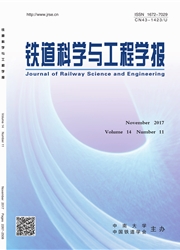

 中文摘要:
中文摘要:
An adaptive current compensation control for a single-sided linear induction motor(SLIM) with nonlinear disturbance observer was developed. First, to maintain t-axis secondary component flux constant with consideration of the specially dynamic eddy-effect(DEE) of the SLIM, a instantaneously tracing compensation of m-axis current component was analyzed. Second,adaptive current compensation based on Taylor-discretization algorithm was proposed. Third, an effective kind of nonlinear disturbance observer(NDOB) was employed to estimate and compensate the undesired load vibrations, then the robustness of the control system could be guaranteed. Experimental verification of the feasibility of the proposed method for an SLIM control system was performed, and it showed that the proposed adaptive compensation scheme with NDOB could significantly promote speed dynamical response and minimize speed ripple under the conditions of external load coupled vibrations and unavoidable feedback control variables measured errors, i.e., current and speed.
 英文摘要:
英文摘要:
An adaptive current compensation control for a single-sided linear induction motor(SLIM) with nonlinear disturbance observer was developed. First, to maintain t-axis secondary component flux constant with consideration of the specially dynamic eddy-effect(DEE) of the SLIM, a instantaneously tracing compensation of m-axis current component was analyzed. Second,adaptive current compensation based on Taylor-discretization algorithm was proposed. Third, an effective kind of nonlinear disturbance observer(NDOB) was employed to estimate and compensate the undesired load vibrations, then the robustness of the control system could be guaranteed. Experimental verification of the feasibility of the proposed method for an SLIM control system was performed, and it showed that the proposed adaptive compensation scheme with NDOB could significantly promote speed dynamical response and minimize speed ripple under the conditions of external load coupled vibrations and unavoidable feedback control variables measured errors, i.e., current and speed.
 同期刊论文项目
同期刊论文项目
 同项目期刊论文
同项目期刊论文
 期刊信息
期刊信息
